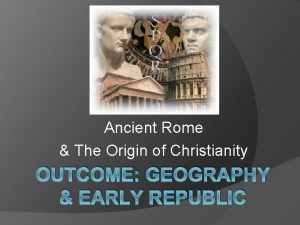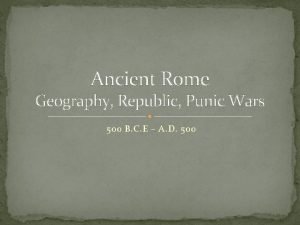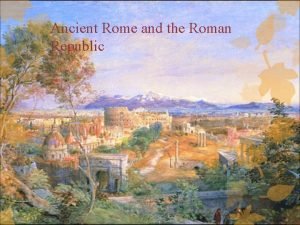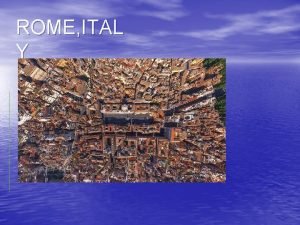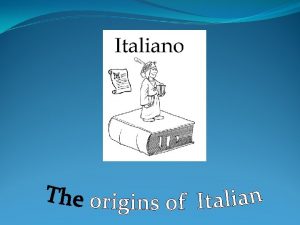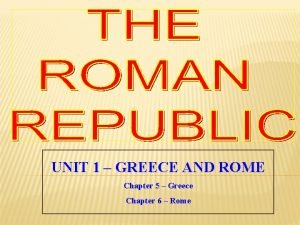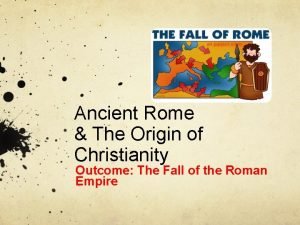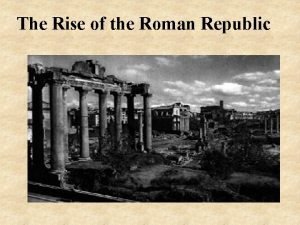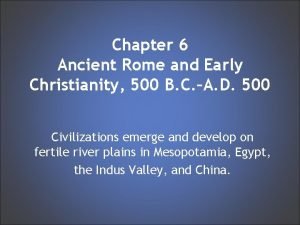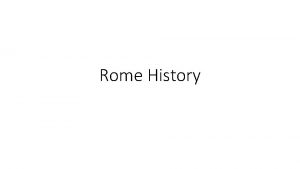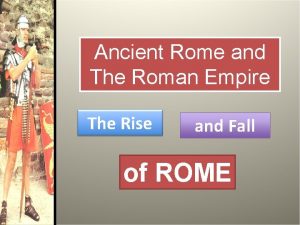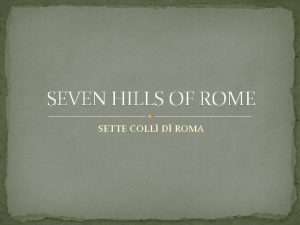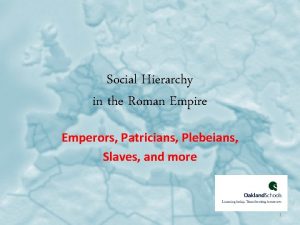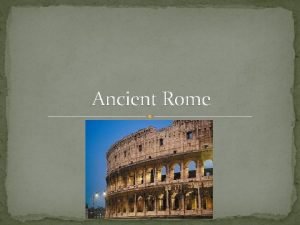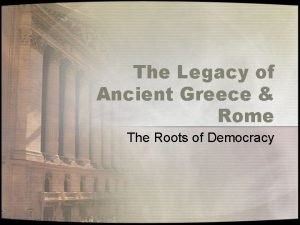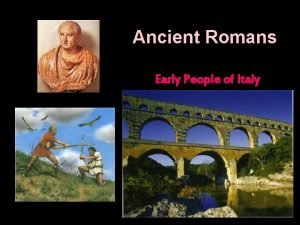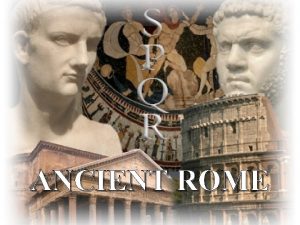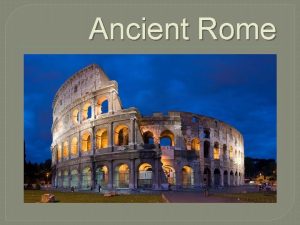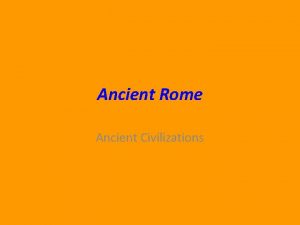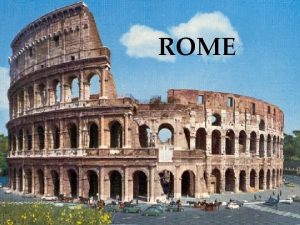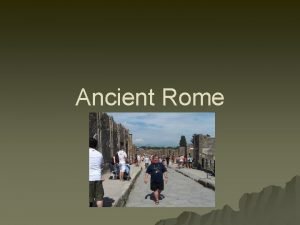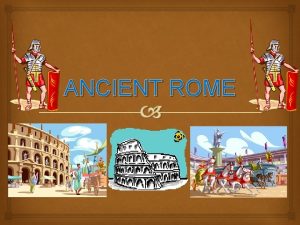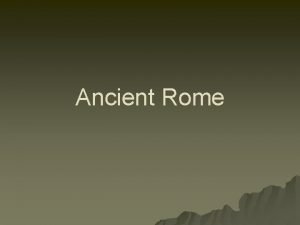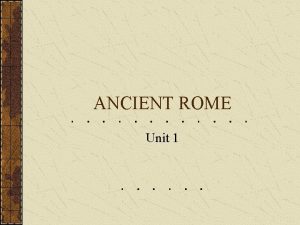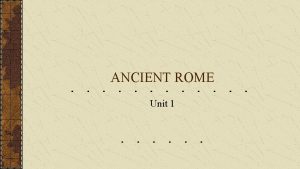Ancient Rome 1 Geography Located on the Italian


















- Slides: 18

Ancient Rome 1

Geography -Located on the Italian peninsula, in the center of the Mediterranean Sea -The Alps are in the North -The Apennine Mts. are on the eastern coast -broad, fertile plains in the north and west 2

Early Civilization -Italy was originally occupied by many different groups of people -Two main groups were Greek colonists and the Etruscans -The Etruscans ruled much of central Italy and Rome itself -Ancestors of the Romans, the Latins, settled in the area that is now Rome around 800 B. C. 3

Legend of the Founding of Rome -Legend has it that twin brothers, Romulus and Remus founded the city -According to the tale, the twins’ mother was a Latin woman and their father was the war god Mars -This led Romans to believe that they had a divine origin 4

Rome Geography Rome is located: -On the banks of the Tiber River -On and around seven hills Why would this geographic location be an advantage? 5

Politics - 509 B. C. Rome is Founded -Romans drove out their Etruscan ruler and established a republic - They did not want one person to have all the power 6

Make up of the Roman Republic • Senate – Only Patricians could be on the Senate • 2 Consuls – Elected from the Senate – Could only serve a 1 year term • Assembly – Patricians and Plebeians 7

Structure of the Republic -Patricians= landholding upper class Plebeians= farmers, merchants, artisans, traders Patricians Plebeians Slaves 8

Separation of Powers • Each group has specific responsibilities that overlap with the responsibilities of the other groups. 2 Consuls Senate Assembly 9

Patricians vs. Plebeians -Plebeians have no say in the government - Eventually get to elect their own officials called tribunes in 494 B. C. - For 84 years, (421 -337 B. C. ) plebeians fought to have a role in each part of the government 10

Social Structures -A man was the head of the household and his wife and children did not question his authority -Over centuries, women received more rights. These included: -Owning property -Running businesses -All children were taught to learn to read and write -Wealthy had private tutors for their children 11

Religion -Romans were polytheistic-they believed in many gods and goddesses -Many of the gods were adapted from the Greek gods Greek God Roman God Zeus-ruler of all gods Jupiter-ruler of all gods Hera-wife of Zeus, protected marriage Juno-wife of Jupiter, protected marriage Poseidon-god of the sea Neptune-god of the sea -Roman calendar is full of feasts and celebrations to honor the gods and goddesses -Temples for worship to ask for divine assistance 12

Politics -Rome grows strong and begins conquering the rest of Italy -By 270 B. C. , Rome controls most of the Italian peninsula -Military is made up of citizens -Rome conquered justly- allowing those conquered to keep their culture, customs, and government- as long as they supplied soldiers, paid taxes, and acknowledge Roman leadership 13

Economics -Conquests brought much wealth to Rome -Wealthy families bought huge estates called latifundia. -Romans forced the people they conquered to work as slaves on the latifundia -Slave labor hurt the small farmers because it cost them more to produce food, and the price was driven down by the immense quantities coming into Rome -Farmers fell into debt, sold their land, and moved to the city looking for work -gap between rich and poor widens=riots and chaos 14

Republic to Empire -Civil wars break out to decide who should hold power. The senate wanted to keep the status quo; political leaders wanted to weaken the senate and enact reforms -Slave uprisings throughout the republic -Armies became loyal to their commanders because they gave them benefits such as captured land. - The new Emperors of Rome then became Army Comamnders 15

PAX ROMANA • Means Roman peace – Period of time when there was no civil wars • Military Commanders become Emperors – Whoever controls the Army has the power • Symbolizes the End of the Roman Republic 16

Emperor of Rome Roman Citizens Rest of the known World 17

18
 Ancient rome outcomes geography and early republic
Ancient rome outcomes geography and early republic Ancient rome geography
Ancient rome geography Geography of ancient rome
Geography of ancient rome Geography of rome
Geography of rome Is rome a peninsula
Is rome a peninsula Italyan alfabesi
Italyan alfabesi Ancient rome tiber river
Ancient rome tiber river Ancient rome and the origins of christianity
Ancient rome and the origins of christianity Byzantine empire facts
Byzantine empire facts Patricians ancient rome
Patricians ancient rome Chapter 6 ancient rome and early christianity
Chapter 6 ancient rome and early christianity Cultural diffusion in rome
Cultural diffusion in rome Ancient rome: the rise and fall of an empire cast
Ancient rome: the rise and fall of an empire cast Seven hills of ancient rome
Seven hills of ancient rome Roman civilization social structure
Roman civilization social structure Rome landmarks
Rome landmarks Physical education in athens
Physical education in athens The legacy of ancient greece and rome
The legacy of ancient greece and rome Assembly ancient rome
Assembly ancient rome
